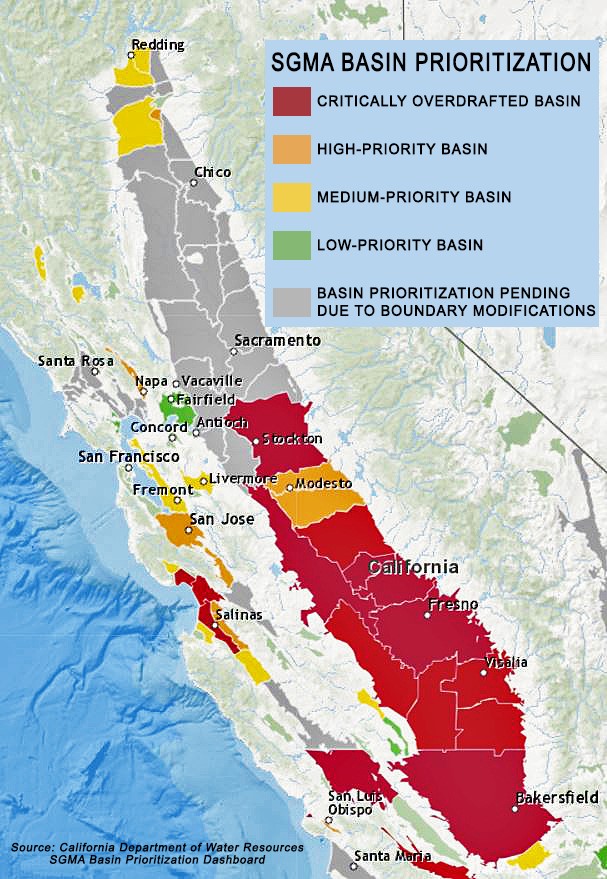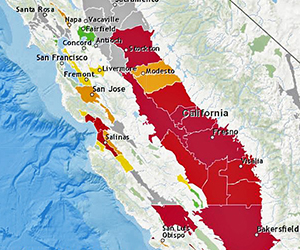Gabriele Ludwig, Director for Sustainability and Environmental Affairs at the Almond Board of California (ABC), recently attended a meeting where State Water Resources Control Board (Water Board) staff presented information regarding the Sustainable Groundwater Management Act, also known as SGMA. We followed up with her after the meeting to hear her key insights from that meeting and implications for almond growers.

With important SGMA regulatory deadlines nearing, Ludwig emphasized that growers need to be at the table and participate on their local Groundwater Sustainability Agencies (GSAs) to contribute in making decisions about groundwater use — not just in the near term, but for years to come.
ABC: By now, most growers have probably heard of SGMA and many are participating in their local irrigation districts and GSAs. Can you give us a quick overview of SGMA for those that may not be up to speed?
Ludwig: SGMA is a game-changer for how groundwater will be managed in the state, by limiting the ability to pump ground water at will. Legislation was passed and signed into law in 2014, which required the creation of GSAs to design plans for bringing groundwater basins into balance and achieving long-term sustainability.
The idea is simple — when SGMA is fully implemented, the amount of water that is pumped out of a groundwater basin must match the amount that is replenished in that basin over time. Though the idea is simple, the implementation will be much more difficult, with major implications for growers located in what are called “high- and medium-priority” basins and “critically overdrafted basins.” As defined by SGMA, “a basin is subject to critical overdraft when continuation of present water management practices would probably result in significant adverse overdraft-related environmental, social, or economic impacts.”
Where are these “critically overdrafted” basins located relative to where almonds are grown?
Parts of San Joaquin, Stanislaus, Merced, Madera, Fresno, Kings, Tulare and Kern counties — home to more than 80% of the California almond acreage — are in critically overdrafted basins. So what does that mean? Critically overdrafted basins must submit Groundwater Sustainability Plans (GSPs) to the California Department of Water Resources (DWR) by January 31, 2020, detailing how they will achieve groundwater sustainability by 2040. The remaining high- and medium-priority basins must submit GSPs by 2022 for achieving groundwater sustainability by 2042.
What happens once Groundwater Sustainability Plans are submitted to the Department of Water Resources?
Once submitted, DWR staff will review individual GSA plans to determine whether the whole basin will be able to meet compliance by 2040. Keep in mind that basins are often comprised of many local GSAs, so the groundwater sustainability plans (GSP) need to show how GSAs are working together to achieve sustainability across the entire basin. If one of the GSA’s plans doesn’t measure up or isn’t complete, then other plans in the basin will also not pass muster.
What happens if a GSA in a critically overdrafted basin doesn’t meet the January 31, 2020 deadline for submitting a GSP?
In the event that a GSA fails to submit a GSP, the Water Board will write a plan for them. That’s an outcome that local GSAs and farmers don’t want, because it relinquishes local control of groundwater management.
All of this is likely to increase the chance of lawsuits, which will lead to adjudication by a court. With adjudication, the court determines the groundwater rights of all the overliers and appropriators of groundwater. They decide who the owners of groundwater are, how much they can extract, and they appoint a Watermaster to ensure the basin or portion of the basin is managed in accordance with the court’s order. Adjudication is a very expensive process. Everyone needs a lawyer and there is no assumption of historical rights. It was pointed out that in adjudication “nobody wins” and all pay dearly to defend their rights.
What’s your advice to growers as we near the deadline for submitting Groundwater Sustainability Plans?
Get involved in your GSA now. Go to the meetings, ask questions, and make sure your GSA is on track to have a Groundwater Sustainability Plan submitted by the January 31, 2020 deadline. Having a detailed roadmap in the form of a GSP is a much better option than having the state dictate how your local area will manage groundwater — or worse yet — having it decided by the court. Getting involved now may also give you an idea of how much water will be available for pumping and how much it will cost in the future.
Growers should also confirm that their GSAs are identifying and maximizing opportunities for groundwater recharge both within agricultural fields and orchards and via dedicated recharge basins. Results from ABC-funded research at UC Davis, which studied almond orchard flooding as a method for groundwater recharge, showed almonds could be used for recharge up until bloom/leaf-out if the orchard has the appropriate sandier soils. Once nitrogen applications are needed for the tree’s production, it is difficult to balance recharge with avoiding nitrate leaching.
It’s important to note that a grower’s involvement in his or her GSA shouldn’t end after plans are submitted to DWR. There’s 20 years of work to be done to bring groundwater basins into balance, and decisions impacting water availability will continue to be made.
How do growers know which GSA they are in, and where do they find more information about how to get involved?
Growers can find their GSA online at the DWR SGMA Portal: SGMA.Water.CA.Gov/Portal. The Almond Board of California also has a quick guide for growers on how to engage with their GSA. It includes more information about how to locate a specific GSA and questions growers should ask at their GSA meetings.
Growers can also contact ABC’s Jesse Roseman, senior specialist of Environmental Affairs, at jroseman@almondboard.com or 209-343-3285. Jesse’s been closely following the SGMA process and can answer growers’ questions.
Growers also have a great opportunity to learn more about SGMA and other California water issues at “Navigating the Waters,” an event that will be hosted by the Almond Board of California on May 14, 2019 at the International Agri-Center in Tulare, California. See the agenda and RSVP information here.


